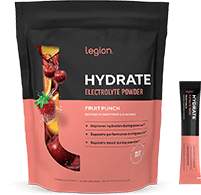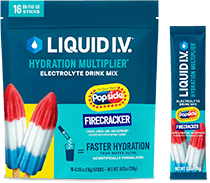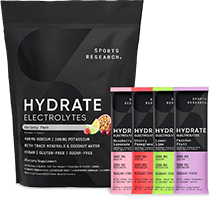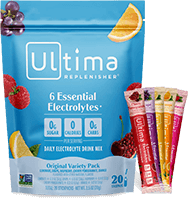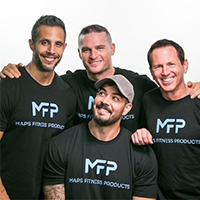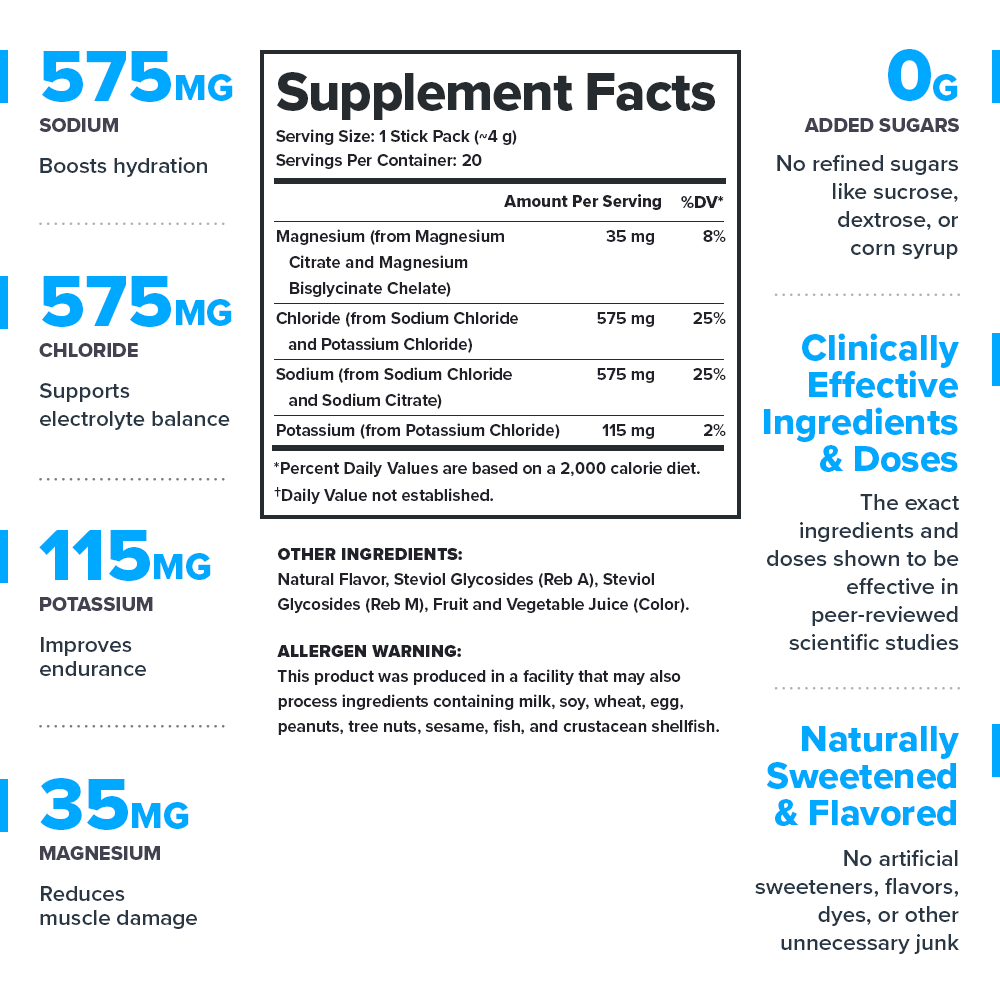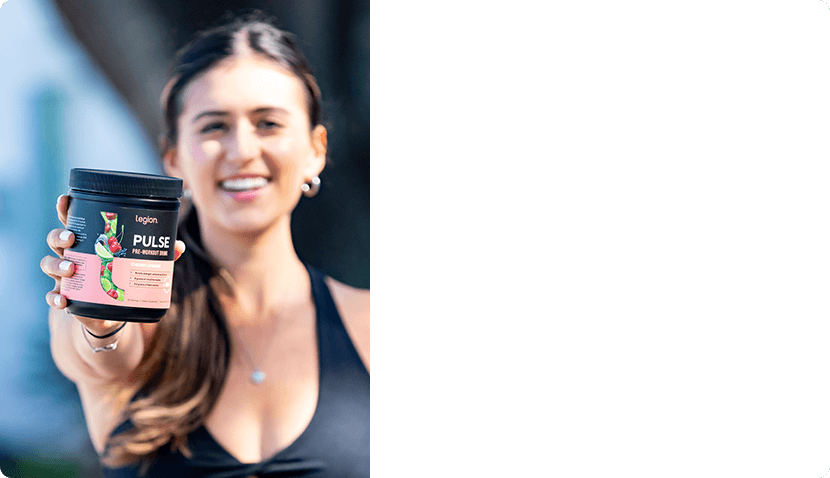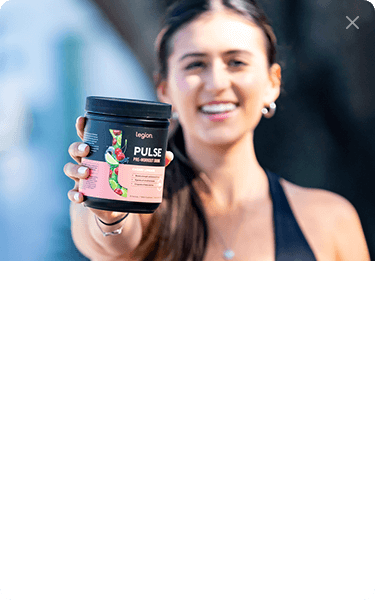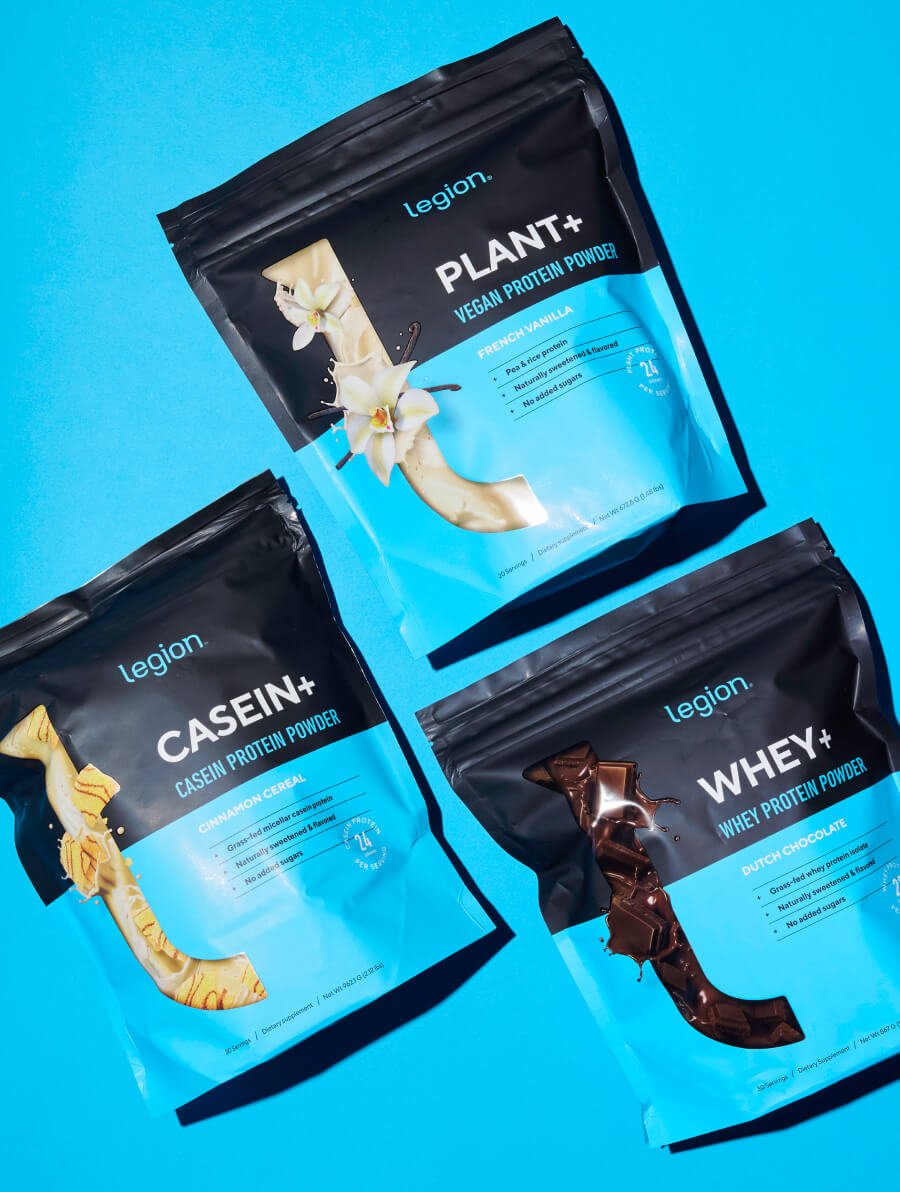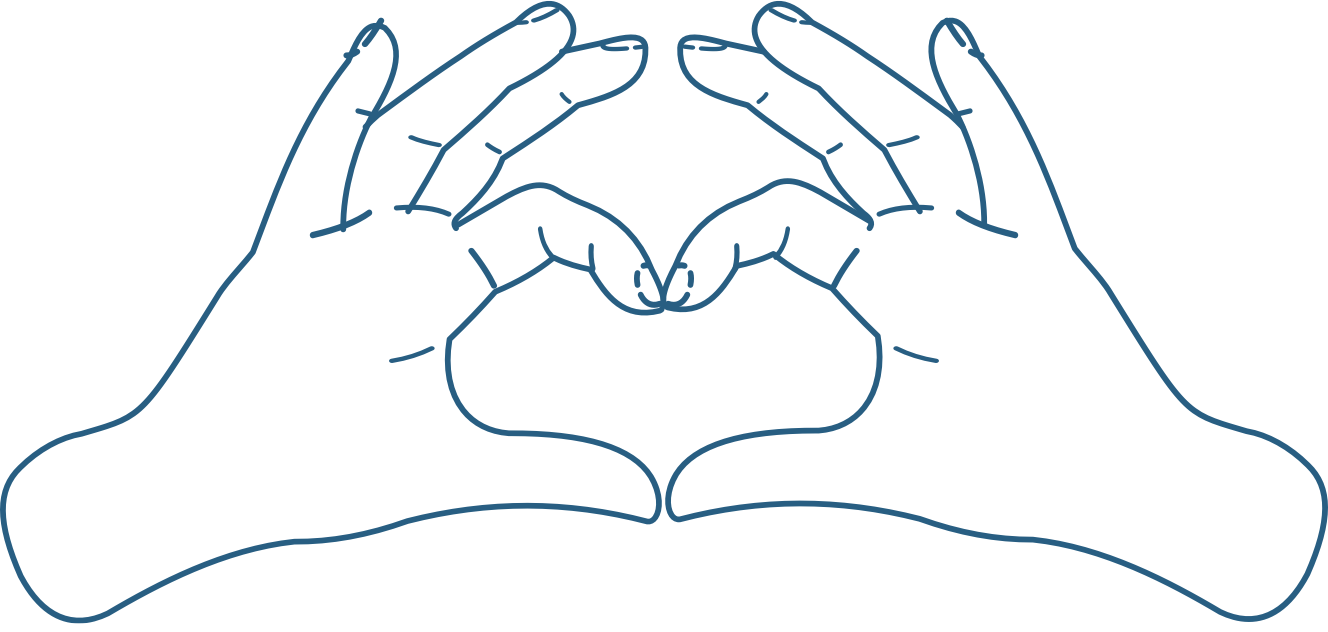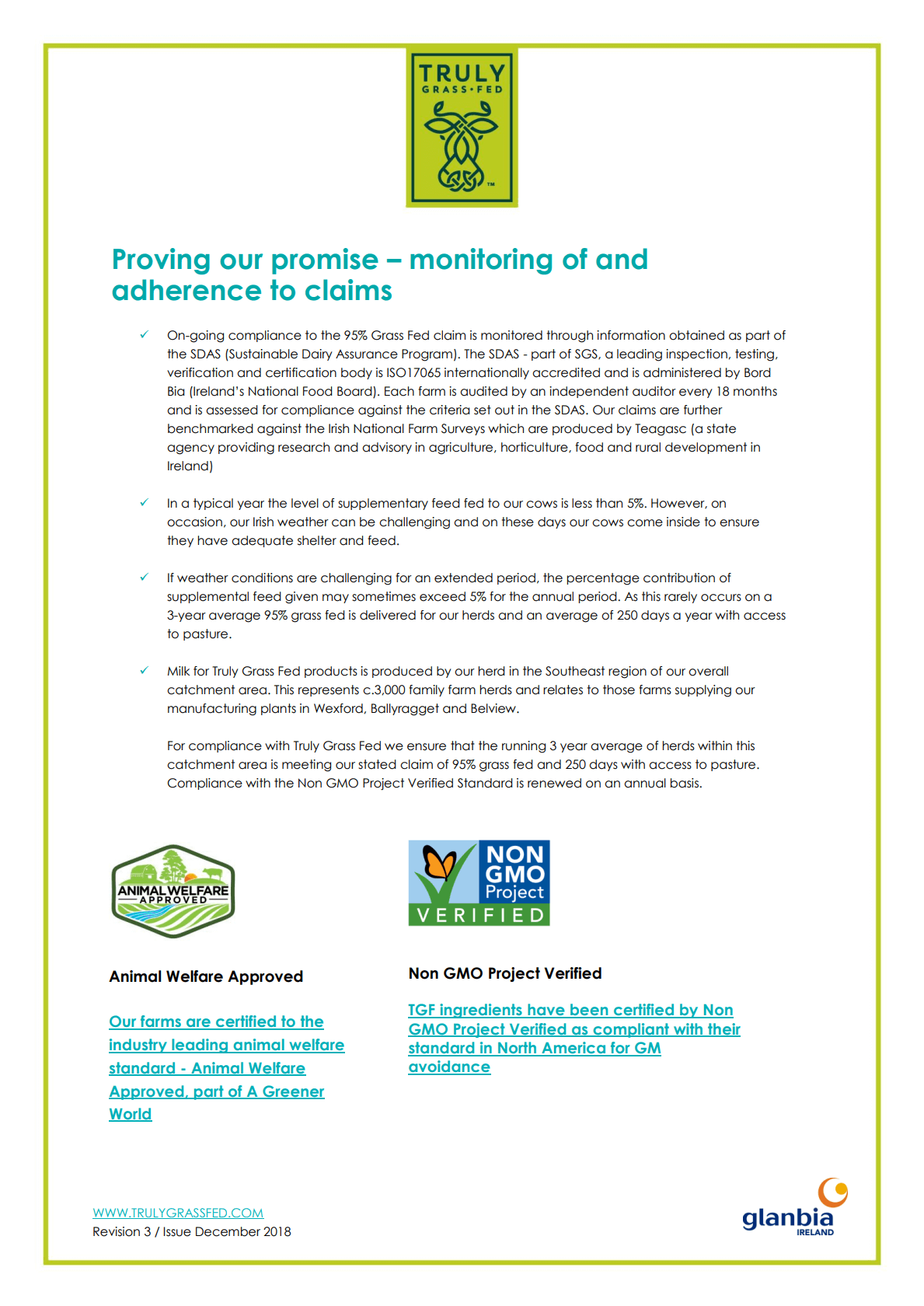Not happy with your purchase?
Simply let us know, and you'll get a full refund, no questions asked. And you don't even need to return anything.
So that means you can say "yes" now and decide later.
Legion Hydrate Ingredients (1,300 milligrams per serving)
Sodium (575 milligrams per serving)
Sodium is a naturally occurring mineral found in rocks, soil, water, and foods like meat, dairy, and vegetables. People have used it for millennia—mostly in the form of sodium chloride or “table salt”—to preserve and season food, trade as currency, and as part of cultural rituals.
Sodium plays many important roles in the body, but one of its most crucial is regulating fluid balance. It pulls water into the spaces around cells and into your bloodstream, and it signals your body to retain more of the fluid you drink, helping you stay hydrated.[6][7][8]
It also works with potassium to produce electrical signals by shifting in and out of cells, allowing your body to contract muscles, send nerve signals, and maintain a steady heartbeat.
Research shows drinking water with sodium can prevent dehydration during exercise and . . .
- Support endurance, especially when exercising in the heat[9][10][11]
- Support post-exercise rehydration[12][13][14][15]
- Help regulate core temperature[16][17]
The clinically effective dose of sodium for supporting hydration depends on how much you lose through sweat.
Hydrate provides 575 milligrams per serving—enough to replace the sodium lost in about 0.7 liters of sweat, which is typical for 30-to-90 minutes of exercise. It also matches the concentration used in research showing benefits without pushing sodium intake too high.[18]

Potassium (115 milligrams per serving)
Potassium is a naturally occurring mineral found in rocks, soil, water, and many foods, especially apricots, lentils, and potatoes.
While sodium regulates fluid outside cells, potassium pulls water into them. This keeps fluid balanced on both sides of the cell membrane, helping with hydration and cellular function.
Potassium also moves in and out of cells to create the electrical charge that your body uses to contract muscles, send nerve signals, and keep your heart beating.
Research shows that drinking water with potassium alongside sodium can prevent dehydration during exercise and . . .
- Reduce fatigue[19][20][21]
- Support endurance and muscle function[22][23][24]
- Sustain focus and coordination[25][26][27]
The clinically effective dose of potassium for supporting hydration depends on how much you lose through sweat.
Hydrate provides 115 milligrams per serving to maintain the same 5-to-1 sodium-to-potassium ratio typically lost in sweat.[28]

Magnesium (35 milligrams per serving)
Magnesium is a naturally occurring mineral found in rocks, soil, water, and foods like nuts, seeds, leafy greens, and legumes.
It’s involved in over 600 enzymatic reactions in the body, including those supporting muscle function, nerve signaling, energy production, and protein synthesis.[29]
Despite its importance, research shows that up to 30% of people don't get enough magnesium from their diet. Active people are especially at risk of deficiency, since exercise increases both magnesium needs and losses, creating a gap that can undermine physical performance.[30][31][32][33]
Research shows that supplementing with magnesium can . . .
- Support energy metabolism and muscle function[34][35]
- Improve strength and power[36][37][38][39]
- Reduce exercise-induced muscle damage[40][41][42][43]
Hydrate provides 35 milligrams of magnesium per serving, which is enough to replace what you typically lose during intense and prolonged exercise (but not enough to meet the recommended daily intake, so eat your vegetables).

Chloride (575 milligrams per serving)
Chloride is a negatively charged ion, or anion, that combines with elements like sodium and potassium to form common salts, such as sodium chloride (table salt) and potassium chloride.
It’s naturally found in water, in minerals like halite (rock salt), and in foods like seaweed, celery, and tomatoes.
Chloride works with sodium to move water into and around your cells, which helps regulate fluid balance throughout your body and keeps you hydrated.
It also helps your muscles contract and your nerves communicate by maintaining proper electrolyte and pH balance across cell membranes.
While some research shows that chloride itself may improve hydration, the primary reason it’s in Hydrate is because it’s bound to sodium (as sodium chloride) and potassium (as potassium chloride).[44]
The clinically effective dose of chloride for supporting hydration depends on how much you lose through sweat.
Hydrate provides 575 milligrams of chloride per serving, which is enough to stabilize the sodium and potassium so they can be absorbed by your body.[45]

Naturally Sweetened and Flavored
While artificial sweeteners may not be as dangerous as some people claim, studies suggest that regular consumption of these chemicals may indeed be harmful to our health.[46][47][48][49][50][51]
That’s why we use the natural sweetener stevia. Research shows that this ingredient is not only safe but can also confer several health benefits, such as supporting weight management, antioxidant activity, digestive health, and more.[52][53][54][55]
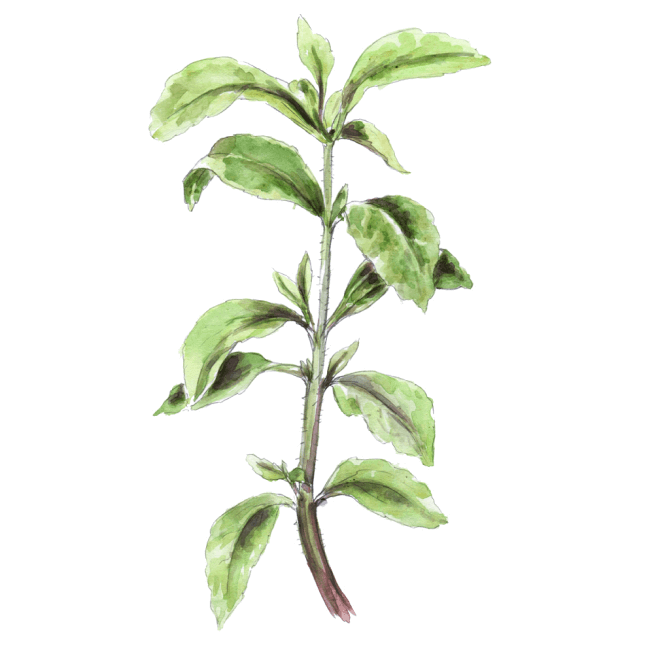
No Artificial Food Dyes, Fillers, or Other Unnecessary Junk
As with artificial sweeteners, studies show that artificial food dyes and fillers can cause negative effects in some people, including gastrointestinal toxicity and behavioral disorders.[56][57][58][59][60]
That’s why we use natural coloring and flavoring derived from fruits and other foods as well as naturally derived ingredients for improving texture, enhancing shelf life, and facilitating the manufacturing process.
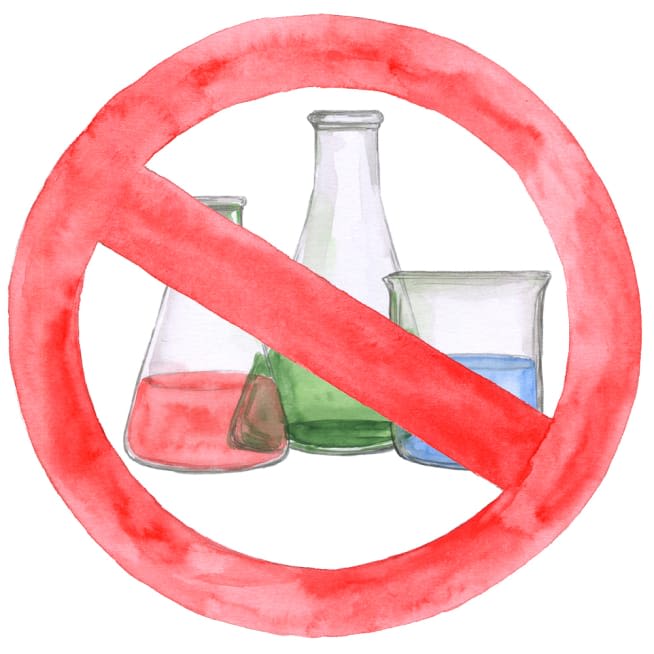
Lab-Tested for Purity and Accuracy
Hydrate is lab-tested for purity and accuracy and certified to meet or exceed FDA and WADA safety guidelines.
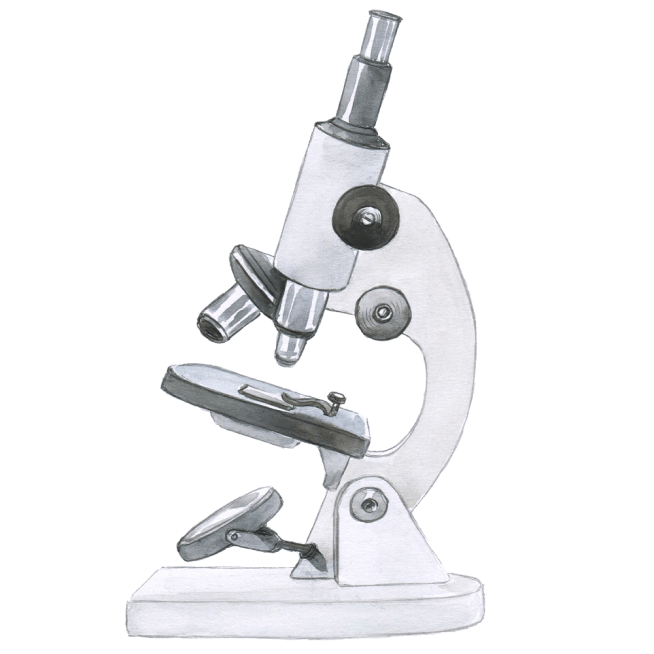
Made in the USA with Globally Sourced Ingredients
If you want to ensure the supplements you’re swallowing every day are safe and effective, you want to buy from a company that:
- Sources ingredients from premium suppliers around the world (great supplements require great raw materials)
- Tests all products for purity and accuracy in accredited laboratories (to conclusively verify safety and efficacy)
- Manufactures in America, which has some of the strictest regulations in the world
And that’s exactly what we do here at Legion.
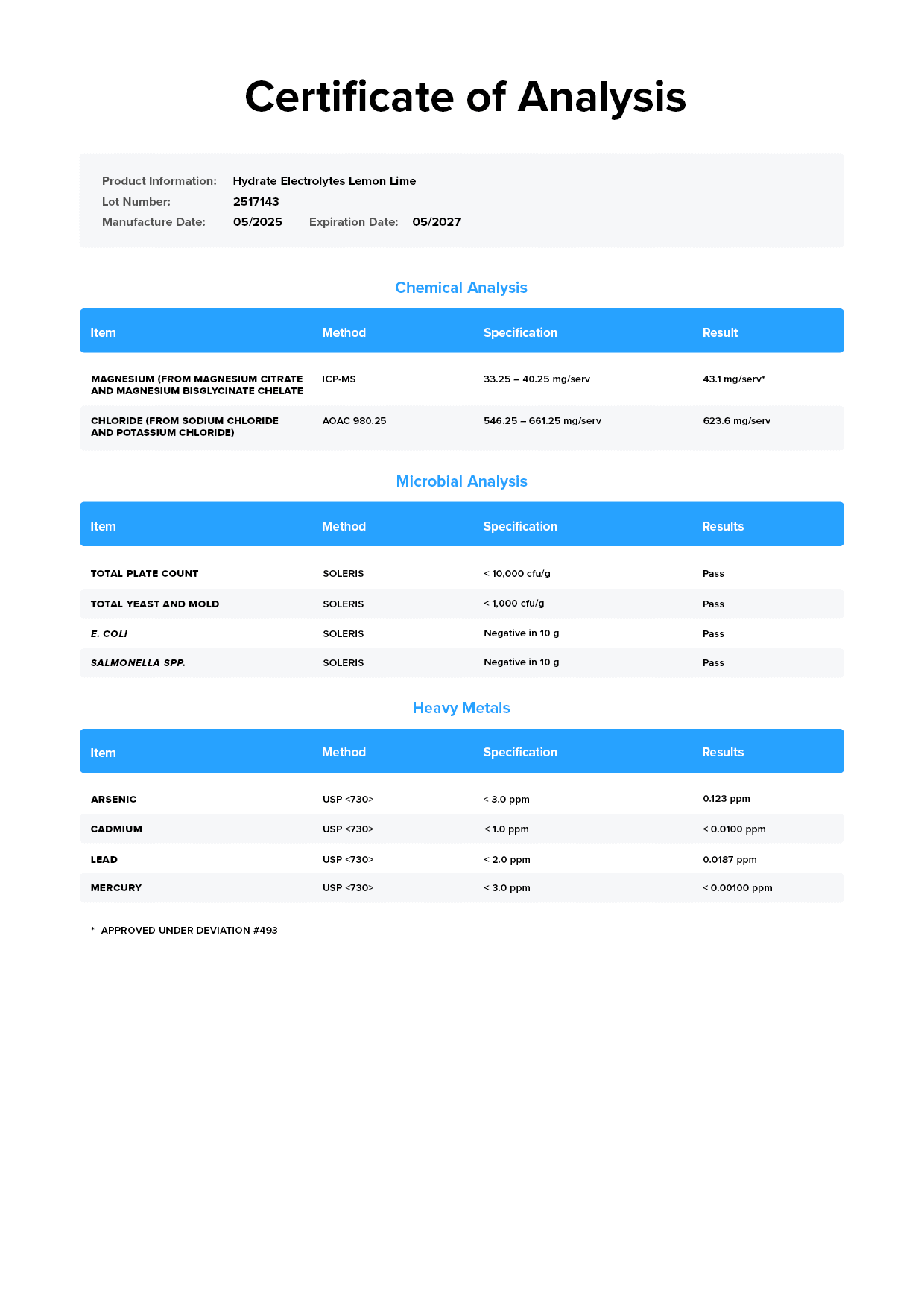
See how Legion Hydrate compares to the rest.
- Active Ingredients
- Clinically Effective Ingredients & Doses
- Sodium
- Potassium
- Magnesium
- Chloride
- Zero Sugar
- Naturally Sweetened & Flavored
- Third-Party Lab Tested
- Labdoor Certified Brand
- Price Per Serving
-
Legion
Hydrate
- 1,300 mg
per serving - 575 mg
per serving - 115 mg
per serving - 35 mg
per serving - 575 mg
per serving
-
Liquid I.V

- 962 mg
per serving - 500 mg
per serving - 370 mg
per serving - $1.56
-
Sports
Research
Electrolytes
- 1,415 mg
per serving - 400 mg
per serving - 200 mg
per serving - 40 mg
per serving - 337 mg
per serving - $1.43
-
Ultima
Replenisher
- 701 mg
per serving - 55 mg
per serving - 250 mg
per serving - 100 mg
per serving - 78 mg
per serving - $0.50
The #1 brand of naturally sweetened and flavored sports supplements.
We’ve sold over 5 million bags and bottles to over 1 million customers in 169 countries who have left us over 55,000 5-star reviews.
Clinically Effective Ingredients and Doses
Every active ingredient, form, and dose in Hydrate is backed by peer-reviewed scientific research demonstrating clear benefits in healthy humans.
Total Label Transparency
We clearly list the dose of each ingredient on our Hydrate label—no proprietary blends or hidden ingredients—so you can verify our formulation’s validity and effectiveness.
Lab-Tested for Purity and Accuracy
Hydrate is lab-tested for purity and accuracy and certified to meet or exceed FDA and WADA safety guidelines.
Naturally Sweetened and Flavored
Hydrate is naturally sweetened with stevia and naturally flavored with extracts from fruit, vegetables, plants and other foods.
Made in the USA
Hydrate is made in America with globally sourced ingredients in NSF-certified, FDA-inspected facilities that adhere to Current Good Manufacturing Practice (cGMP) standards.
100% Money-Back Guarantee
If you don't absolutely love Hydrate, you get a prompt and courteous refund. No forms or returns necessary.
Trusted by scientists, doctors, and everyday fitness folk alike.
Frequently Asked Questions
+References
While artificial sweeteners may not be as dangerous as some people claim, studies suggest that regular consumption of these chemicals may indeed be harmful to our health. That’s why we use the natural sweetener stevia instead.↑
113 peer-reviewed scientific studies support Hydrate’s ingredients and doses. That’s 904 pages of scientific research that shows Hydrate works the way we say it does.↑
Hydrate contains the precise ingredients, forms, and doses used in peer-reviewed scientific research demonstrating clear benefits in healthy humans.↑
View Supplement Facts↑
View Supplement Facts↑
Many supplement ingredients lack scientific validation in humans—we aren't large rodents, after all.
And even when ingredients have proven benefits, they're often used in doses too small to be effective.
That's why we exclusively use ingredients and doses shown to work in peer-reviewed scientific studies on healthy men and women.↑
Unlike a supplement like creatine or vitamin D, an electrolyte supplement isn't recommended for everyone.
In fact, according to the current weight of the scientific evidence, most people will notice little or no benefit from an electrolyte powder beyond "tasty water."
That said, there is one group of people who can benefit: those who do long (60+ minute), sweaty workouts, typically in hotter environments.
If you're one of those people, this supplement may be worth adding to your regimen. If you’re not, however, it's almost certainly not worth it, unless your only goal is to make water easier to drink.↑
While artificial sweeteners, food dyes, and fillers may not be as dangerous as some people claim, studies suggest that regular consumption of these chemicals may indeed be harmful to our health.
That’s why we use naturally derived alternatives instead like stevia, allulose, monk fruit, and fruit extracts.↑
That’s 904 pages of scientific research that shows Hydrate works the way we say it does.↑
Did you know that some supplements contain dangerously high levels of toxins like lead, arsenic, and cadmium?
That’s why we rigorously test every batch and guarantee our products provide exactly what the labels claim—and nothing else.
With Legion, you can be certain that what you're putting into your body is truly safe and effective.
View Latest Lab Results↑
Luetkemeier MJ, Coles MG, Askew EW. Sports Med. 1997;23(5):279-286. doi:10.2165/00007256-199723050-00002↑
Maughan RJ, Watson P, Cordery PA, et al. Am J Clin Nutr. 2016;103(3):717-723. doi:10.3945/ajcn.115.114769↑
Sims ST, van Vliet L, Cotter JD, Rehrer NJ. Med Sci Sports Exerc. 2007;39(1):123-130. doi:10.1249/01.mss.0000241639.97972.4a↑
Sims ST, Rehrer NJ, Bell ML, Cotter JD. J Appl Physiol (1985). 2007;103(2):534-541. doi:10.1152/japplphysiol.01203.2006↑
Del Coso J, González-Millán C, Salinero JJ, et al. Scand J Med Sci Sports. 2016;26(2):156-164. doi:10.1111/sms.12427↑
Hamouti N, Fernández-Elías VE, Ortega JF, Mora-Rodriguez R. Scand J Med Sci Sports. 2014;24(3):507-518. doi:10.1111/sms.12028↑
Maughan RJ, Leiper JB. Eur J Appl Physiol Occup Physiol. 1995;71(4):311-319. doi:10.1007/BF00240410↑
Merson SJ, Maughan RJ, Shirreffs SM. Eur J Appl Physiol. 2008;103(5):585-594. doi:10.1007/s00421-008-0748-0↑
Shirreffs SM, Taylor AJ, Leiper JB, Maughan RJ. Med Sci Sports Exerc. 1996;28(10):1260-1271. doi:10.1097/00005768-199610000-00009↑
Krisher L, Butler-Dawson J, Yoder H, et al. J Occup Environ Med. 2020;62(12):e696-e703. doi:10.1097/JOM.0000000000002033↑
McCubbin AJ, Lopez MB, Cox GR, Caldwell Odgers JN, Costa RJS. Eur J Appl Physiol. 2019;119(9):2105-2118. doi:10.1007/s00421-019-04199-2↑
Sims ST, Rehrer NJ, Bell ML, Cotter JD. J Appl Physiol. 2007;103(2):534-541. doi:10.1152/japplphysiol.01203.2006↑
American College of Sports Medicine, Sawka MN, Burke LM, et al. Med Sci Sports Exerc. 2007;39(2):377-390. doi:10.1249/mss.0b013e31802ca597↑
Maughan RJ, Watson P, Cordery PA, et al. Am J Clin Nutr. 2016;103(3):717-723. doi:10.3945/ajcn.115.114769↑
American College of Sports Medicine, Sawka MN, Burke LM, et al. Med Sci Sports Exerc. 2007;39(2):377-390. doi:10.1249/mss.0b013e31802ca597↑
Armstrong LE, Ganio MS, Casa DJ, et al. J Nutr. 2012;142(2):382-388. doi:10.3945/jn.111.142000↑
Ganio MS, Armstrong LE, Casa DJ, et al. Br J Nutr. 2011;106(10):1535-1543. doi:10.1017/S0007114511002005↑
American College of Sports Medicine, Armstrong LE, Casa DJ, et al. Med Sci Sports Exerc. 2007;39(3):556-572. doi:10.1249/MSS.0b013e31802fa199↑
Tsintzas OK, Williams C, Singh R, Wilson W, Burrin J. Eur J Appl Physiol Occup Physiol. 1995;70(2):154-160. doi:10.1007/BF00361543↑
Wittbrodt MT, Millard-Stafford M. Med Sci Sports Exerc. 2018;50(11):2360-2368. doi:10.1249/MSS.0000000000001682↑
Lorenzo I, Serra-Prat M, Yébenes JC. Nutrients. 2019;11(8):1857. Published 2019 Aug 9. doi:10.3390/nu11081857↑
Yu-Yahiro JA. Orthop Nurs. 1994;13(5):38-40. doi:10.1097/00006416-199409000-00008↑
Baker LB, Wolfe AS. Eur J Appl Physiol. 2020;120(4):719-752. doi:10.1007/s00421-020-04323-7↑
Dominguez LJ, Veronese N, Ragusa FS, et al. Nutrients. 2025;17(10):1655. Published 2025 May 13. doi:10.3390/nu17101655↑
DiNicolantonio JJ, O'Keefe JH, Wilson W. Open Heart. 2018;5(1):e000668. Published 2018 Jan 13. doi:10.1136/openhrt-2017-000668↑
Sims ST, Rehrer NJ, Bell ML, Cotter JD. J Appl Physiol. 2007;103(2):534–541. doi:10.1152/japplphysiol.01203.2006↑
Buchman AL, Keen C, Commisso J, et al. J Am Coll Nutr. 1998;17(2):124-127. doi:10.1080/07315724.1998.10718737↑
Nielsen FH, Lukaski HC. Magnes Res. 2006;19(3):180-189↑
Dominguez LJ, Veronese N, Ragusa FS, et al. Nutrients. 2025;17(10):1655. Published 2025 May 13. doi:10.3390/nu17101655↑
Liguori S, Moretti A, Paoletta M, Gimigliano F, Iolascon G. Int J Mol Sci. 2024;25(20):11220. doi:10.3390/ijms252011220↑
Santos DA, Matias CN, Monteiro CP, et al. Magnes Res. 2011;24(4):215-219. doi:10.1684/mrh.2011.0290↑
Brilla LR, Haley TF. J Am Coll Nutr. 1992;11(3):326-329. doi:10.1080/07315724.1992.10718233↑
Matias CN, Santos DA, Monteiro CP, et al. Magnes Res. 2010;23(3):138-141. doi:10.1684/mrh.2010.0217↑
Setaro L, Santos-Silva PR, Nakano EY, et al. J Sports Sci. 2014;32(5):438-445. doi:10.1080/02640414.2013.828847↑
Córdova Martínez A, Fernández-Lázaro D, Mielgo-Ayuso J, Seco Calvo J, Caballero García A. Magnes Res. 2017;30(2):61-70. doi:10.1684/mrh.2017.0424↑
Tarsitano MG, Quinzi F, Folino K, Greco F, Oranges FP, Cerulli C, et al. J Transl Med. 2024;22:629. doi:10.1186/s12967-024-05434-x↑
Córdova A, Mielgo-Ayuso J, Roche E, Caballero-García A, Fernandez-Lázaro D. Nutrients. 2019;11(8):1927. Published 2019 Aug 16. doi:10.3390/nu11081927↑
Steward CJ, Zhou Y, Keane G, Cook MD, Liu Y, Cullen T. Eur J Appl Physiol. 2019;119(11-12):2617-2627. doi:10.1007/s00421-019-04238-y↑
Del Coso J, González-Millán C, Salinero JJ, et al. Scand J Med Sci Sports. 2016;26(2):156-164. doi:10.1111/sms.12427↑
Baker LB, De Chavez PJD, Ungaro CT, et al. Eur J Appl Physiol. 2019;119(2):361-375. doi:10.1007/s00421-018-4048-z↑
Abou-Donia MB, El-Masry EM, Abdel-Rahman AA, McLendon RE, Schiffman SS. J Toxicol Environ Health A. 2008;71(21):1415-1429. doi:10.1080/15287390802328630↑
Qin X. Can J Gastroenterol. 2011;25(9):511. doi:10.1155/2011/451036↑
Schernhammer ES, Bertrand KA, Birmann BM, Sampson L, Willett WC, Feskanich D. Am J Clin Nutr. 2012;96(6):1419-1428. doi:10.3945/ajcn.111.030833↑
Fowler SP, Williams K, Resendez RG, Hunt KJ, Hazuda HP, Stern MP. Obesity (Silver Spring). 2008;16(8):1894-1900. doi:10.1038/oby.2008.284↑
Sylvetsky A, Rother KI, Brown R. Pediatr Clin North Am. 2011;58(6):1467-xi. doi:10.1016/j.pcl.2011.09.007↑
Yang Q. Yale J Biol Med. 2010;83(2):101-108↑
Peteliuk V, Rybchuk L, Bayliak M, Storey KB, Lushchak O. EXCLI J. 2021;20:1412-1430. Published 2021 Sep 22. doi:10.17179/excli2021-4211↑
Samuel P, Ayoob KT, Magnuson BA, et al. J Nutr. 2018;148(7):1186S-1205S. doi:10.1093/jn/nxy102↑
Ahmad J, Khan I, Blundell R, Azzopardi J, Mahomoodally MF. Trends Food Sci Technol. 2020;100:177-189. doi:10.1016/J.TIFS.2020.04.030↑
Kasti AN, Nikolaki MD, Synodinou KD, et al. Microorganisms. 2022;10(4):744. Published 2022 Mar 30. doi:10.3390/microorganisms10040744↑
Feng J, Cerniglia CE, Chen H. Division of Microbiology, National Center for Toxicological Research, US Food and Drug Administration, AR , USA. Front Biosci (Elite Ed). 2012 Jan 1;4:568-86. ↑
Kanarek RB. Department of Psychology, Tufts University, Medford, Massachusetts, USA. Nutr Rev. 2011 Jul;69(7):385-91. ↑
Nigg JT, Lewis K, Edinger T, Falk M. Oregon Health and Science University, Portland, OR, USA. J Am Acad Child Adolesc Psychiatry. 2012 Jan;51(1):86-97.e8. ↑
McCann D, Barrett A, Cooper A, Crumpler D, Dalen L, Grimshaw K, Kitchin E, Lok K, Porteous L, Prince E, Sonuga-Barke E, Warner JO, Stevenson J. School of Psychology, Department of Child Health, University of Southampton, Southampton, UK. Lancet. 2007 Nov 3;370(9598):1560-7. ↑
Gao Y, Li C, Shen J, Yin H, An X, Jin H. Scientific and Technological College of Chemistry and Biology, Yantai Univ., Yantai, PR China. J Food Sci. 2011 Aug;76(6):T125-9. ↑
